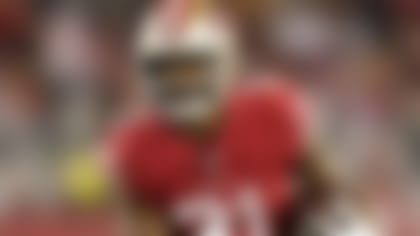There hasn't been much offseason buzz in fantasy circles surrounding the Bengals' backfield thus far. That's probably because we sort of already know what we're getting in terms of role and workload for each back; Jeremy Hill is focusing on rebounding following an inconsistent season and a devastating fumble in the AFC Wild Card game, while Giovani Bernard signed a three-year extension with Cincinnati as he heads into his fourth pro campaign. The main question when it comes to these running backs is: Can Hill be more efficient as a runner and serve as more than an elite goal-line back, and will Bernard find ways to get into the end zone more often following a career-low two-touchdown campaign?
Best backfield tandem in the NFL
Over the past two seasons, no running back duo in the NFL has been more productive than Jeremy Hill and Giovani Bernard.
The Cincinnati tandem ranks first in combined carries (767), rush yards (3,328), rushing touchdowns (27) and scrimmage yards (4,443) since 2014. And while both backs have received similar volume in that span--Hill has averaged 15.2 touches per game while Bernard has averaged 14.3--Hill gets the nod as the better fantasy asset due to his nose for the end zone with 21 total touchdowns compared to Bernard's nine. In fact, Hill leads the NFL in rushing touchdowns (20) since he entered the league in 2014.
The one-two punch combined for 14 total touchdowns and over 2,000 yards from scrimmage last year in a Bengals offense that averaged 26.2 points per game, seventh in the NFL. But despite those impressive combined numbers, Hill and Bernard had an up-and-down kind of campaign in terms of fantasy production. Let's dive into how they performed individually.
Hill's touchdown or bust sophomore campaign
Due to Hill's 'bust' status in fantasy, given his fringe first-round asking price last year, his ADP in standard leagues this season has plummeted into Round 5. For a running back who tied for the league lead in rushing touchdowns a season ago (11), that's quite the fall from grace. His 3.6 yards per carry average has a lot to do with his devaluation heading into 2016. It makes sense given that Hill was the only top-15 fantasy running back to record fewer than 900 rushing yards for the year and average fewer than 60 scrimmage yards per game. You can't win weekly matchups with that kind of inefficiency from a guy you drafted to be your RB1.
Hill's scoring, which somewhat saved his season from a fantasy perspective, came in bunches: Nine of his 11 rushing touchdowns came in four multi-score games randomly spaced out throughout the year. Hill scored twice in Week 1, three times in Week 4, twice in Week 11 (by this point his owners had likely given up on him as a fantasy starter) and twice in Week 15. Of Hill's 11 touchdown runs in the regular season, five of them were 1-yard runs and four of them were for five or fewer yards. His longest run of the entire year came in Week 17 when he scored on a 38-yard scamper against Baltimore. Prior to that, his longest run was a mere 17 yards. So in short, when he wasn't getting into the end zone, he was the epitome of a dud in fantasy, with a ceiling of 6.8 standard fantasy points in games without a score. The weeks where he didn't hit pay dirt, he was essentially not startable. If his touchdowns had been more spaced out rather than scored in clusters, we might be looking at Hill differently ahead of the upcoming season.
To add to the frustration, if at any point during the season you were advised to use Hill as a matchup-based starter, then you probably would not have deployed him in Week 4 against Kansas City (three touchdowns, 24 fantasy points), Week 6 against Buffalo (one receiving touchdown, 12 fantasy points) or Week 11 against Arizona (two touchdowns, 16.5 fantasy points). And if you missed out on those games there were not many other instances where Hill came through. As you might have concluded by now, fantasy owners definitely have good reason to fade Hill in drafts this year.
Bernard's tale of consistency
Adversely, Giovani Bernard had no trouble putting up respectable fantasy point totals for the first half of the season despite scoring just twice all year. And while his production tailed off in the final six weeks, he still finished as a top 25 fantasy running back with over 1,200 scrimmage yards and an average of 8.3 fantasy points per game. He averaged 75.1 scrimmage yards per game with a 4.7 yards per carry average and finished the year with just 23 fewer fantasy points than his teammate even though he scored 10 fewer times. Bernard was more consistent than Hill in terms of total yardage production on a weekly basis. He registered just a single week with a top 10 fantasy finish among running backs, but provided a solid floor, finishing inside the top 25 among running backs nine times.
Bernard also ranked second in the NFL last year in terms of player percentage of team third down plays last season with 83.66, second only to Danny Woodhead (85.28). Bernard's third-down usage was among the tops in the NFL but it doesn't necessarily mean he was actually touching the ball on all of those snaps. In fact, he only touched the ball 39 times out of 169 third down plays, or 23 percent. FantasyData.com's Touch Percentage statistic, or the percentage of snaps played where a player touched the football (includes pass attempts, rush attempts and receptions) helps to put Bernard's workload into perspective versus Hill's. Despite being out-snapped by Bernard by a count of 585 to 459, Hill's overall touch percentage was 52 percent (ranked 10th among running backs) compared to Bernard's 35 percent (47th among running backs). In other words, Cincinnati was committed to feeding Hill the ball when he was on the field despite his struggles with efficiency.
Valuation for 2016
In standard formats, Jeremy Hill is currently being drafted after players like Jeremy Langford (part of a three-headed committee in Chicago), DeMarco Murray (on one of the worst offenses in the NFL) and Dion Lewis (PUP, knee). Hill was one of just 10 running backs to receive greater than 220 rush attempts last season and he's essentially a lock to repeat that kind of volume heading into this season. That automatically makes him a more attractive draft option than the aforementioned players he's going behind. From a rushing yardage standpoint, it'd be difficult for Hill to perform as poorly as he did last year for a second straight season on similar volume.
So if you want to be a savvy fantasy owner who picks up one of the best bargains at running back this year, look no further than Hill. He's got volume upside, double-digit touchdown potential, and remains the primary running back in one of the NFL's most potent offenses.
Look, I get it. Jeremy Hill burned you last year because you probably drafted him as your RB1, so you're going to pivot to Giovani Bernard who owns an asking price of Round 7. This is fine ... if you want to overpay for a running back who has never totaled greater than 170 rush attempts in a single season and has seen his volume and touchdown total decrease with each passing year. There's a chance that Bernard's low touchdown rate last season was an anomaly according to JJ Zachariason of numberFire. Still, for a guy who owns a touchdown ceiling of seven through three seasons, a Round 7 asking price feels high.
If you are going to argue that Bernard is a better option than Hill in PPR formats, well, you would be correct. But that also does not mean he is a PPR stud. In fact, Bernard ranked inside the top 10 among running backs last year in both targets (66) and receptions (49) but finished as the RB16 in PPR scoring. Hill finished as the RB20 in PPR despite hauling in just 15 receptions for the season. And all of that is due to touchdown scoring, or in Bernard's case, the lack thereof.
At the end of the day, I'm not saying that Bernard is a bad option in fantasy if you decide to go wide receiver-heavy early on. But with his Round 7 asking price, I find him being drafted before I feel comfortable taking him in just about every mock or MFL10 I've participated in. On the flip side, I find people passing up on Hill frequently and due to the volume upside and bounce back potential, I keep finding myself thinking that he is too good of a player who has a cemented high-volume role to let slide at his current cost as an RB3 or flex option.
Why wait? CLICK HERE to get your 2016 NFL Fantasy season started.
-- Follow Matt on Twitter @MattFranchise and like his page on Facebook










